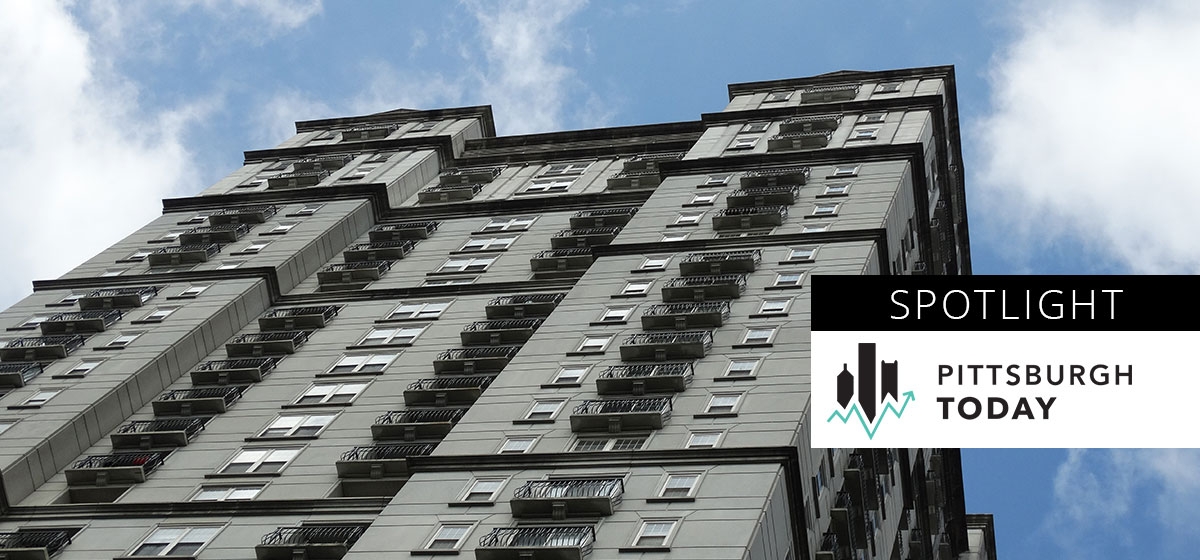Desperate for Affordable Housing, Cities Try Rewriting Zoning Laws

The last Penn Plaza apartments were vacated on a cold February day in 2017, ending an exodus of 200 tenants from one of the largest complexes of affordable housing in Pittsburgh. News that the private owner planned to raze the apartments to accommodate upscale development caught the city off guard a year earlier and taxed the nonprofits and volunteers who mobilized to find housing the uprooted tenants could afford in an East Liberty neighborhood where rents and real estate values were soaring well out of their price range.
The high-profile drama cast light on a shortage of affordable housing that Pittsburgh and other cities across the country are trying to solve using a range of options, the most controversial of which is inclusionary zoning.
Inclusionary zoning seeks to compel private developers to price a percentage of units in new projects below market rate by making it mandatory or by offering them incentives. The decades-old concept has become a popular way for local governments to generate affordable housing through the private sector. Cities in 25 states have adopted the zoning in some form and the idea of requiring affordable housing set-asides is something City of Pittsburgh officials are exploring.
Heightened demand
Finding housing that doesn’t consume more than 30 percent of their earnings has become more challenging for Americans earning less than the median income, particularly in neighborhoods where real estate and rents are surging.
The median household income in the City of Pittsburgh is $42,450, the U.S. Census Bureau estimates.
The lower a person’s income, the more problematic housing becomes. Only 35 affordable homes are available for every 100 households earning 30 percent of the median income—a shortage of 7 million units nationwide, according to the National Low Income Housing Coalition, which tracks housing for extremely low-income Americans, who account for 25 percent of U.S. renters.
Pittsburgh has 45 affordable units for every 100 of those households, the second highest rate among U.S. cities. Yet, it is 17,300 units short of meeting the needs of residents who earn no more than 50 percent of the median income, the city’s Affordable Housing Task Force reports.
‘Drip by drip’
Lawrenceville is in the midst of one of the most profound housing market shifts in the city, one that’s been accompanied by the kind of business growth, rising popularity and revitalization that other neighborhoods desire. Median home prices, for example, increased more than 150 percent from 2010 to 2017, according to MLS, a real estate marketing service.
But with resurgence has come high housing costs. Median rent is up to $1,300 a month for a one-bedroom apartment, which isn’t considered affordable for someone earning 80 percent of the median income. And the neighborhood has lost half of the 234 “choice voucher” units that very low-income families can afford with the help of federal subsidies.
Unlike Penn Plaza, most people affected by the shortage are not displaced by a single real estate transaction. “It’s drip by drip,” said Dave Breingan, executive director of Lawrenceville United, a city neighborhood group. “One landlord chooses to renovate. One landlord says, ‘I don’t need Section 8 anymore.’ It’s lot of individual choices. It’s harder to see and harder to mitigate.”
In Lawrenceville, several strategies are being pursued, including a community land trust, which is expected to finance seven new homes in its first phase. And neighborhood groups are drafting a proposal to add inclusionary zoning to their toolbox and become the first neighborhood in the city to require developers to include affordable units in future projects.
Leveraging the private sector
Nearly 900 jurisdictions nationwide have such ordinances. Most are in Massachusetts, New Jersey and California, according to Grounded Solutions Network, which provides technical assistance on such policies.
Some ordinances require developers to price a percentage of units below-market-rate. Others make that an option, offering incentives such as density bonuses that let them add more units to a project, raising its revenue potential. Developers are often permitted to contribute to a housing fund in lieu of adding affordable units themselves, or they’re allowed to build those units off site.
The goal is to add housing affordable for residents with incomes ranging from 30 percent to 80 percent of the local median income. The share of units set aside for such housing ranges from 5 to 20 percent.
The effectiveness of inclusionary zoning and its impact on local markets is still debated. Studies find it typically produces affordable housing, but not enough to make it a stand-alone solution to inventory shortfalls. Making it mandatory tends to create more units than giving developers the option to include below-market-rate housing in their projects.
But developers chafe at such mandates, which make recovering the cost of building affordable units difficult. And such ordinances have faced legal and political challenges.
“I’m not opposed to the concept. I’m concerned about the implementation. These projects are not easily profitable,” said Steven Guy, president and CEO of Pittsburgh-based Oxford Development Company. “If it’s something that doesn’t work, [developers] will do something different, move on to office, to another asset class, and we won’t add any inventory.”
Proof of concept
Pittsburgh is new to inclusionary zoning. The city’s two recent incentive-based voluntary inclusionary housing plans in the Uptown EcoInnovation District and along its riverfronts remain untested.
The city also plans to give mandatory inclusionary zoning a try in a pilot neighborhood, which Lawrenceville is the current favorite to become. The city’s affordable housing task force recommends that developers be required to make 10-15 percent of new units affordable to residents earning 80 percent of the median income or less, depending on the strength of the neighborhood market. Property tax exemptions would be included to help offset their costs.
As a laboratory, the pilot could help answer the critical question of how much affordable housing a city can demand from developers without discouraging development. “That’s one reason we’re proceeding with caution and doing a pilot before making it citywide,” city Planning Director Ray Gastil said. “The proof will be in the pudding.”
NEXT WEEK: Finding a workable formula for including affordable housing in new market-rate development is a complex challenge





